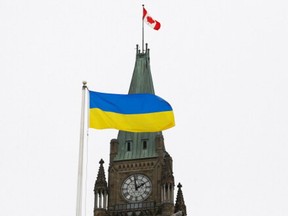'We’ve been very cautious, even selfish, on equipment. We could take a lot more chances,' said retired Gen. Rick Hillier
Get the latest from John Ivison straight to your inbox

OTTAWA — For decades, Prestwick Airport was the only airport in Scotland offering transatlantic flights — hundreds of thousands of Scots flew to their new home in Canada from the west-coast hub.
Now, Canadians are going the other way. In March, the military set up a facility at Prestwick to receive and redirect cargo aid to Ukraine. This week, Defence Minister Anita Anand said the detachment would be expanded to 55 Canadian Forces personnel and a third aircraft added to transport equipment. The facility now proudly boasts a piece of A4 paper with the words: “Welcome to CFB Prestwick” printed on them.
The NP Comment newsletter from columnist Colby Cosh and NP Comment editors tackles the important topics with boldness, verve and wit. Get NP Platformed delivered to your inbox weekdays by 4 p.m. ET.
The question is: What exactly is the new air mobility hub going to be trans-shipping?
As the CBC’s Murray Brewster reported last week, the Ukrainian government has handed Canada a new list of the military hardware and support it would like to receive.
-

Adam Zivo: Canada should expel Russian ambassador after he lied about Izyum mass grave
-

Opinion: NATO needs to play a bigger role in the Arctic. And Canada needs to let it
People who have seen the communiqué said the Ukrainians have requested winter clothing, ammunition for the howitzers Canada has already sent, bridging and pontoon equipment and armoured vehicles with 25mm chain guns.
The request is in keeping with a commitment by U.S. Defence Secretary Lloyd Austin “to move even faster and push even harder” when it comes to equipping Ukraine. NATO armament directors are set to meet to discuss what member countries might contribute.
So far, Canadian ministers have deflected questions about the government’s next move. Anand said Canada has already provided $600 million in military aid and “we will continue to be there for Ukraine.” Finance Minister Chrystia Freeland said the government knows more is needed “and we’re focused on that.”
One of Ukraine’s requests has been for modern tanks. The most appropriate from a training and logistics perspective would be the German-made Leopard tank, of which Canada operates around 60.
However, Germany has a longstanding policy of refusing to export arms to conflict zones and has been reluctant to give permits to countries like Spain that use Leopards and are willing to donate them.
Canada has committed 39 armoured vehicles, which Anand said are “en route” to Ukraine.
But the Canadian Forces’ stockpile of equipment is running low.
Not only is the cupboard bare, the military is reluctant to part with any more of its weaponry.
Former chief of the defence staff, retired Gen. Rick Hillier, thinks there is an obvious solution that plays to Canada’s strengths — an ambitious ramping up of the training that the Forces are providing to the Ukrainian army.
“We’ve been very cautious, even selfish, on equipment. We could take a lot more chances — for example take 300 LAV111s, send them to Ukraine and challenge General Dynamics Land Systems to replace them with a better vehicle for the Canadian Army. We’ve done some good things, but the first $500 million is gone and my question is where is the next $500 million going? Here’s where I think it should go: There’s an opportunity here, a niche where Canada could build a legacy and step up on the training piece in a way that’s not been contemplated so far. It would be a wonderful thing to do and Canadians would support it in the extreme.”
Hillier said that the Armed Forces and private Canadian companies that already carry out training for NATO allies could set up a training centre in, for example, Poland, to train Ukraine’s territorial defence force.
In August, the government committed 255 personnel for a four-month training exercise in the United Kingdom, to help turn Ukrainian civilians into front-line troops. Canadian troops will augment British efforts to provide basic and specialized five-week military training programs.
It is a role familiar to our Forces. Prior to the war, Canada trained 33,000 Ukrainian soldiers as part of Operation Unifier, which was halted when Russia invaded in February.
Cabinet has already given authorization for up to 400 trainers, so Hillier’s call to expand and extend the commitment is logical.
“President Zelenskyy has talked about a one-million person army being the requirement to eject the Russians and secure the border. To do that, you need training in basic soldiering, you need training in leadership, you need technical training and then you need to repeat that stuff on and on and on,” said Hillier.
“I’d love to see Canada come with a vision of what we’re going to do. It probably wouldn’t cost more than $50 million a year. Just think, $250 million over five years and you could have a huge impact down the road.”
Hillier said he looks back at Operation Unifier as an example of what can be achieved. “It’s no stretch of the imagination to say a good part of the success the Ukrainian Defence Forces have had in the fight against Russia in the last eight months has been because of the training that was delivered to them. It gave them the confidence to fight and defend their country,” he said.
The Ukrainians remain focused on hardware, judging by the requests handed to the government. But Hillier is right. “It’s pointless to keep asking Canada for things we don’t have,” he said.
His preference is for Canada to “go big” in helping the Ukrainians “shape a professional military force, based on the right values and skill sets, in a uniquely Canadian way.”
jivison@postmedia.com
Twitter.com/IvisonJ
Get the latest from John Ivison straight to your inbox


